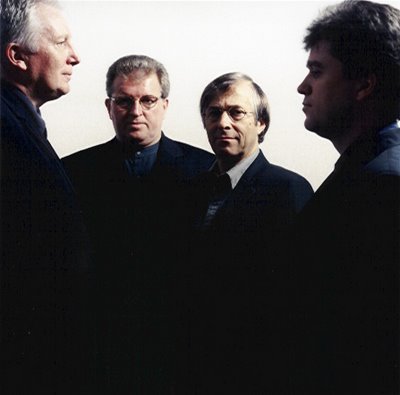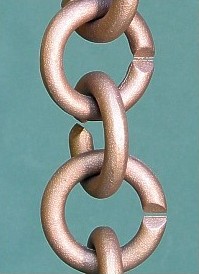
Hilliard Ensemble (L to R, Gordon Jones, David James, Rogers Covey-Crump, Steven Harrold), photo by Friedrun Reinhold |
The Freer Gallery of Art hosts an eclectic and sporadic
series of free concerts, often in sync with the museum's beautiful exhibits. To cap off the fascinating exhibit on early Bible manuscripts at the Sackler Gallery (see the
Ionarts review), the
Hilliard Ensemble brought a program called
Arkhangelos, modern and older pieces in the Catholic and Orthodox traditions, to the Meyer Auditorium on Wednesday night. The group is known primarily for their exquisite recordings and live performances of Renaissance and medieval polyphony, as in their acclaimed 2006 CD of music by Gombert. The Hilliards also commission and perform new works of music, and that was the focus of this thorny and challenging concert.
The program takes its name,
Arkhangelos, from a piece of that title by English composer Ivan Moody (b. 1964). The text is a 6th-century poem by Agathius Scholasticus, about how a person's mind is affected by meditating on an icon of St. Michael. The musical setting is appropriately inward and mysterious, mostly with very pretty sounds. It goes well with a piece near it in the program, Arvo Pärt's
Most Holy Mother of God, an ecstatic litany on the words "Most Holy Mother of God, save us" premiered by the Hilliard Ensemble in 2005. The texture of this piece alternates between layering of slow melodic lines and a harried homorhythmic mantra-like section, which grows from piano in an arching crescendo.
The group also had fine moments in another work composed for them, Alexander Raskatov's
Praise, a setting of five liturgical texts from the Liturgy of St. John Chrysostom. The very dissonant logic of the first piece,
Hymn of the Cherubim, meant that at crucial points, unisons solemnly resolved to seconds, as Raskatov used grating dissonance, piled up in succession, to propel the piece through rocking swells. The opposite effect is achieved in the second piece,
The Lord's Prayer, where at certain points the four voices end up on the same note in four different octaves.
Gentle Light contrasts the declamation of the text in highest and lowest voices with an ison (drone) of ostinato with glissandi in the middle voices. The fourth movement's speech rhythms were, frankly, a little silly, but the minimalistic repetition of the pulsing fifth movement was exciting, speeding up like a whirling dervish to a sudden end.
Hilliard Ensemble:

Gombert (2006)
Review

Mnemosyne, with Jan Garbarek (1999) |
The program mostly favored the Hilliard Ensemble's strengths, able as they are to sing with pure intonation even the most complex and dissonant harmonies, with the tightest control of a wide range of dynamics. This was the first time I had heard any of the music that the Hilliard Ensemble recorded on a 2004 trip to Armenia, arrangements by a monk-composer named Komitas of traditional Armenian sacred songs called
sharakans. Most of them were unremarkable -- static, atmospheric pieces with drones and cantillation effects -- but
Surp, Ter zorutheanc (the text of the Latin Sanctus) was lovely.
The group's vocal quality occasionally shows its age, but nothing more serious than an occasional instability or stridency. Countertenor David James sounded slightly constricted and scratchy in the Nonantolan chant
Ote to stauron he sang alone. However, he also had an excellent turn on the top of
Sirt in sasani, the strangest and most intriguing
sharakan. Its text puzzled me ("My heart trembles, I am terrified, on account of Judah") because it is so fragmentary. After some reflection, the source came to me, from the prophecy of Egypt's fall to Israel (Isaiah 19:16-17), with an interesting liturgical twist, to cast the text in the voice of an Egyptian:
In that day the Egyptians will be like women. They will shudder with fear at the uplifted hand that the LORD Almighty raises against them. And the land of Judah will bring terror to the Egyptians; everyone to whom Judah is mentioned will be terrified, because of what the LORD Almighty is planning against them.
Baritone Gordon Jones's solo in one of the Armenian pieces,
Bazmutyung hreshtakac, revealed a voice still remarkably round and full. Although this was an excellent program, I confess with some guilt that my hunger for some Gombert or Tallis only worsened as the evening progressed. That desire was to remain unsated, as even the encore was a modern piece, an arrangement by Estonian composer Veljo Tormis of a traditional lullaby the group recorded on their 1999 recording with saxophonist Jan Garbarek.
The next classical concerts at the Freer Gallery of Art are the second and third appearances of the Musicians from Marlboro (March 28 and May 9). The Hilliard Ensemble's remaining concerts on this American tour take them to Chicago (this evening), Pittsburgh (January 27), and Cleveland (January 28).
 As the previous post should have indicated, American composer Philip Glass is 70 years old today. In honor of this milestone, English National Opera and the Metropolitan Opera have undertaken a new production of the composer's opera Satyagraha, scheduled for this April at ENO and next year at the Met. We offer some past Ionarts coverage of the music of Philip Glass and, in a separate post, a review by Jens of the essential recordings.
As the previous post should have indicated, American composer Philip Glass is 70 years old today. In honor of this milestone, English National Opera and the Metropolitan Opera have undertaken a new production of the composer's opera Satyagraha, scheduled for this April at ENO and next year at the Met. We offer some past Ionarts coverage of the music of Philip Glass and, in a separate post, a review by Jens of the essential recordings.











 J.S.Bach / Loussier, The Brandenburgs,
J.S.Bach / Loussier, The Brandenburgs, 

























































